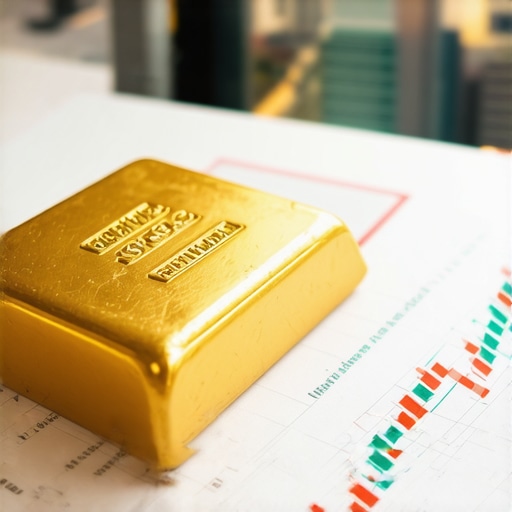What Are Gold ETFs and Why Should You Consider Investing?
Gold has always been a valuable asset, often seen as a safe haven during economic uncertainty. As investors seek ways to gain exposure to gold without the hassles of physical ownership, Gold ETFs (Exchange-Traded Funds) have emerged as a popular choice. These funds allow you to invest in gold without the need to store or manage physical gold bullion. In this guide, we will explore the fundamentals of Gold ETFs and how they can be a smart addition to your investment portfolio.
How Gold ETFs Work: A Simplified Explanation
Gold ETFs are investment funds that are traded on stock exchanges, similar to stocks. Each share of a Gold ETF represents a fraction of an ounce of gold, which is held in a secure vault by a custodian. This structure provides investors with the ability to buy and sell shares of gold in real-time, making it a liquid and accessible investment option.
When you invest in a Gold ETF, you gain exposure to the fluctuations in gold prices without the need to physically buy, sell, or store gold. This makes them an appealing choice for those who want to invest in gold while avoiding the logistical challenges associated with owning physical gold.
Benefits of Investing in Gold ETFs
Investing in Gold ETFs comes with several benefits:
- Liquidity: Gold ETFs can be easily bought and sold on the stock market, providing investors with quick access to their funds.
- Low Management Fees: Compared to actively managed mutual funds, Gold ETFs typically have lower expense ratios, making them a cost-effective option.
- Diversification: Gold ETFs provide an easy way to diversify your investment portfolio, especially during times of market volatility.
Considerations Before Investing in Gold ETFs
While Gold ETFs offer numerous advantages, it’s essential to consider some factors before diving into this investment:
- Market Risk: Like any investment, Gold ETFs are subject to market fluctuations. Prices can be volatile, so it’s crucial to assess your risk tolerance.
- Tracking Error: Some Gold ETFs may not perfectly track the price of gold due to management fees and other factors. Always review the fund’s performance against gold prices.
In summary, Gold ETFs present a convenient and efficient way to invest in gold. By understanding the mechanics of these investment vehicles, you can make informed decisions that align with your financial goals. If you’re looking to explore further, check out our post on best gold investment methods or read more about the varied types of gold investments to broaden your investment knowledge.
Choosing the Right Gold ETF: Factors to Consider
When deciding on a Gold ETF to invest in, it’s essential to evaluate various factors to ensure it aligns with your investment strategy. Consider the fund’s expense ratio, which affects your overall returns. Lower fees generally mean more of your investment goes toward gold rather than management costs.
Another critical factor is the fund’s performance history. Reviewing how well the ETF has tracked the price of gold over time can provide insights into its reliability. Additionally, assess the liquidity of the ETF, as this indicates how easily you can buy or sell shares without impacting the market price.
Different Types of Gold ETFs: Finding Your Fit
There are two primary types of Gold ETFs: physical-backed ETFs and futures-based ETFs. Physical-backed ETFs hold actual gold bullion in secure vaults and are often favored by investors looking for a direct link to gold prices. On the other hand, futures-based ETFs invest in gold futures contracts, which can lead to different risk profiles and price behaviors.
Understanding these distinctions is vital for formulating your investment strategy. If you prefer direct exposure to gold, a physical-backed ETF may be more suitable. However, if you’re interested in leveraging price movements, a futures-based ETF might align better with your objectives.
Tax Implications of Investing in Gold ETFs
Investing in Gold ETFs also comes with specific tax considerations. Generally, profits from Gold ETFs are taxed as collectibles, which can lead to higher capital gains tax rates compared to other investments such as stocks. It’s crucial to consult with a tax professional to understand how these rules apply to your specific situation.
Being informed about the tax implications can help you make more strategic decisions and maximize your overall returns. For an in-depth look at investment options, you might also find our article on best gold investment methods for 2025 helpful.
Market Trends and the Future of Gold ETFs
The landscape of Gold ETFs is continuously evolving. As market dynamics change, so do the strategies investors use to navigate them. Keeping an eye on market trends is essential for making informed decisions. For instance, during times of economic uncertainty, demand for gold and gold-related investments typically increases.
Investors should also stay updated on the gold price forecast, as fluctuations can significantly impact the performance of Gold ETFs. Understanding these trends can enhance your ability to time your investments effectively. You can read more about these trends in our post on gold price forecasts to gain insights into potential future movements.
Conclusion: Making Informed Decisions with Gold ETFs
In conclusion, Gold ETFs offer a flexible and efficient way to invest in gold while avoiding the complexities of physical ownership. By understanding how they work, the factors to consider when choosing one, and the market trends affecting gold prices, you can position yourself for success in the gold investment arena. Whether you’re a seasoned investor or just starting, Gold ETFs can be a valuable addition to your investment strategy. As you explore your options, remember to evaluate your risk tolerance and investment goals.
Understanding Gold ETF Advantages: Why Investors Choose Them
Gold ETFs offer numerous advantages for investors looking to diversify their portfolios. One significant benefit is the liquidity they provide. Unlike physical gold, which can be cumbersome to buy and sell, Gold ETFs can be traded on stock exchanges, making it easy to enter or exit positions quickly.
Another advantage is the cost efficiency associated with Gold ETFs. They typically have lower management fees compared to mutual funds that invest in gold, allowing more of your money to be allocated toward gold itself rather than expenses. This aspect is particularly appealing to long-term investors aiming to maximize their returns over time.
Risks of Investing in Gold ETFs: What You Need to Know
While Gold ETFs present several benefits, investors should also be aware of the risks involved. One of the primary risks is market volatility. Gold prices can fluctuate significantly due to various factors, including economic data, geopolitical events, and changes in interest rates. As a result, the value of your Gold ETF investment can experience sharp ups and downs.
Additionally, it’s essential to consider the tracking error of the ETF. This refers to the difference between the ETF’s performance and the actual price of gold. A higher tracking error may indicate that the ETF is not accurately reflecting gold price movements, which could impact your investment returns.
How to Analyze Gold ETFs: Key Metrics to Evaluate
When evaluating Gold ETFs, several key metrics can help you make informed decisions. First, examine the expense ratio to understand how much you’ll pay in fees. A lower expense ratio is generally more favorable, as it means more of your investment goes toward gold rather than administrative costs.
Next, consider the fund size. Larger funds tend to be more stable and have better liquidity, making them easier to trade. Additionally, look at the ETF’s historical performance to assess how well it has tracked gold prices over time. Reliable performance history can indicate a well-managed fund that may be a sound investment.
Investment Strategies for Gold ETFs: Maximizing Your Returns
To maximize your returns when investing in Gold ETFs, consider employing various strategies. One effective approach is to use a dollar-cost averaging strategy. By investing a fixed amount at regular intervals, you can reduce the impact of market volatility on your overall investment.
Another strategy is to align your Gold ETF investments with your overall financial goals. Whether you’re seeking long-term growth or a hedge against inflation, ensure that your investment aligns with your strategy. For more insights on effective investment strategies, refer to our article on best practices for gold investment strategies.
Conclusion: Navigating the Gold ETF Landscape
In summary, understanding the benefits and risks associated with Gold ETFs is crucial for making informed investment decisions. These financial instruments offer a unique way to gain exposure to gold without the complexities of physical ownership. By carefully analyzing Gold ETFs and employing sound investment strategies, you can position yourself for success in the evolving gold market. For further exploration of gold investments, check out our comprehensive guide on understanding the varied types of gold investments.
Understanding the Tax Implications of Gold ETFs
Investors should also be aware of the tax implications associated with Gold ETFs. In many jurisdictions, gains from the sale of Gold ETFs are taxed as collectibles, which can lead to a higher capital gains tax rate compared to standard stock investments. This is crucial for long-term investors as it can affect your overall returns. For a deeper understanding of these implications, consider exploring resources on gold demand fluctuations and their potential impacts on investment strategies.
Diversifying Your Portfolio with Gold ETFs
Gold ETFs serve as an effective tool for portfolio diversification. By incorporating gold into your investment mix, you can reduce overall portfolio risk, particularly in times of economic uncertainty. Gold often behaves differently from stocks and bonds, making it a valuable asset in balancing your investments. To learn more about incorporating gold into your portfolio, check out our guide on evaluating the best types of gold investments.
Monitoring Gold ETF Performance: Key Metrics
Keeping track of your Gold ETF’s performance is essential for informed decision-making. Key performance metrics include the annualized return, which shows how much your investment has grown over time, and the Sharpe ratio, which measures the risk-adjusted return of the fund. Higher Sharpe ratios indicate a more favorable return relative to the risks taken. Additionally, it’s beneficial to review the ETF’s holdings to ensure it aligns with your investment goals.
Conclusion: Making Informed Decisions in the Gold ETF Market
In conclusion, while Gold ETFs present a unique opportunity for investors looking to diversify their portfolios, it is imperative to understand both the benefits and risks involved. By considering factors such as tax implications, performance metrics, and the role of gold in your overall investment strategy, you can navigate the gold ETF landscape more effectively. For further insights into maximizing your gold investments, refer to our article on gold investment strategies for 2025.
Comprehensive FAQ Section on Gold ETFs
What are Gold ETFs and how do they work?
Gold ETFs, or Gold Exchange-Traded Funds, are investment funds that trade on stock exchanges, similar to stocks. They track the price of gold bullion and allow investors to gain exposure to gold without the need to physically own it. Each share of a Gold ETF represents a specific amount of gold, making it a convenient way to invest in this precious metal.
Are Gold ETFs a safe investment?
While Gold ETFs are generally considered a safer investment compared to physical gold due to lower storage costs and liquidity, they are not without risks. Investors should consider market fluctuations and potential management fees. However, they can serve as a hedge against inflation and economic downturns, which adds to their appeal.
How do I choose the best Gold ETF?
To select the best Gold ETF, consider factors such as the fund’s expense ratio, liquidity, tracking error, and the reputation of the issuer. Additionally, assess the fund’s performance history and how closely it tracks the price of gold. Researching different options can help you find a fund that aligns with your investment goals.
Can I hold Gold ETFs in a retirement account?
Yes, Gold ETFs can be held in various types of retirement accounts, such as IRAs. This allows investors to incorporate gold as part of their retirement strategy, benefiting from potential tax advantages while still gaining exposure to the gold market.
What are the tax implications of investing in Gold ETFs?
Investments in Gold ETFs may be subject to different tax treatments compared to stocks. In many jurisdictions, profits from the sale of Gold ETFs are taxed as collectibles, which can result in higher capital gains tax rates. It is essential to consult with a tax professional to understand the specific implications for your situation.
How do Gold ETFs perform in economic downturns?
Gold ETFs often perform well during economic downturns as gold is traditionally viewed as a safe-haven asset. Investors tend to flock to gold during times of uncertainty, which can drive up the price of gold and, consequently, the value of Gold ETFs.
What are the advantages of investing in Gold ETFs over physical gold?
Gold ETFs offer several advantages over physical gold, including increased liquidity, lower transaction costs, and no need for storage or insurance. Additionally, Gold ETFs can be easily bought and sold on stock exchanges, providing investors with greater flexibility.
Can I lose money with Gold ETFs?
Yes, like any investment, there is a risk of losing money with Gold ETFs. The price of gold can fluctuate based on various factors, including market demand, geopolitical events, and economic conditions. Therefore, it is crucial to conduct thorough research and consider your risk tolerance before investing.
Are there any fees associated with Gold ETFs?
Yes, Gold ETFs typically charge management fees, which can vary by fund. These fees are expressed as an expense ratio and can impact your overall returns. It’s essential to factor in these costs when evaluating different Gold ETFs.
Authority Resources for Gold ETF Investors
For those looking to deepen their understanding of Gold ETFs and investment strategies, several authoritative resources are available:
- SPDR Gold Shares – A leading Gold ETF provider offering insights and market updates.
- Investopedia – Gold ETF Guide – Comprehensive articles and tutorials on Gold ETFs and investment strategies.
- World Gold Council – Provides research and insights on the gold market and investment opportunities.
- Morningstar – Offers fund ratings and analysis, including for Gold ETFs.
- Bloomberg – Financial news and data, including gold market trends and ETF performance metrics.
Conclusion: Empowering Your Investment Journey with Gold ETFs
In summary, Gold ETFs offer a unique opportunity to diversify your investment portfolio and hedge against economic volatility. By understanding the various aspects, including tax implications, performance metrics, and the advantages of Gold ETFs over physical gold, investors can make informed decisions. Utilize the resources provided to stay updated with market trends and continue enhancing your investment strategy in the world of Gold ETFs.











This is a helpful, approachable breakdown — thanks for laying out the basics so clearly. A quick personal note: I started adding a small allocation (around 3–5%) to a physical-backed Gold ETF two years ago as a volatility hedge, and I’ve appreciated the liquidity and avoidance of storage hassles. Two practical things I watch closely that aren’t always obvious are (1) tracking error over multiple market cycles and (2) who the custodian is and whether the fund publishes regular vault audits — those factors made me choose a larger, well-established issuer despite a marginally higher expense ratio.
Also, the tax treatment you mentioned is important: I moved most of my gold exposure into a retirement account to simplify tax consequences, though that’s not an option for everyone. For those weighing physical-backed versus futures-based ETFs, I’ve found futures funds can diverge more in volatile months.
Curious to hear from others: how do you size gold allocations in portfolios today, and do you prefer physical-backed ETFs or futures-based ones — and why?
This post offers a comprehensive overview of Gold ETFs, which I find incredibly helpful for investors trying to understand the nuances of this investment vehicle. I’ve personally been leaning toward physical-backed ETFs because I value the tangible link to gold, especially during economic uncertainties. However, I acknowledge that futures-based ETFs can provide more leverage, though they come with different risks and potential divergences from spot gold prices, especially during volatile periods.
One aspect I think about often is the importance of the fund’s storage arrangements and audit transparency. Knowing that the vaults are regularly audited and that a reputable custodian manages the fund provides an extra layer of confidence. Does anyone have insights or experiences with the newer ETFs that claim to store gold in fully insured, audited facilities but at a lower cost?
Finally, I’d love to hear how others are balancing gold in their portfolios now—are you increasing allocations as a hedge or maintaining a small, consistent position? What strategies seem most effective in the current market environment?